San Francisco International Airport
| San Francisco International Airport | |||||||||||||||||||||||
|---|---|---|---|---|---|---|---|---|---|---|---|---|---|---|---|---|---|---|---|---|---|---|---|
 | |||||||||||||||||||||||
 | |||||||||||||||||||||||
|
IATA: SFO – ICAO: KSFO – FAA LID: SFO – WMO: 72494 | |||||||||||||||||||||||
| Summary | |||||||||||||||||||||||
| Airport type | Public | ||||||||||||||||||||||
| Owner | City & County of San Francisco | ||||||||||||||||||||||
| Operator | San Francisco Airport Commission | ||||||||||||||||||||||
| Serves | San Francisco | ||||||||||||||||||||||
| Location | San Mateo County (unincorporated) | ||||||||||||||||||||||
| Hub for | |||||||||||||||||||||||
| Elevation AMSL | 13 ft / 4 m | ||||||||||||||||||||||
| Coordinates | 37°37′08″N 122°22′30″W / 37.61889°N 122.37500°WCoordinates: 37°37′08″N 122°22′30″W / 37.61889°N 122.37500°W | ||||||||||||||||||||||
| Website | FlySFO.com | ||||||||||||||||||||||
| Map | |||||||||||||||||||||||
 SFO Location | |||||||||||||||||||||||
| Runways | |||||||||||||||||||||||
| |||||||||||||||||||||||
| Statistics (2014) | |||||||||||||||||||||||
| |||||||||||||||||||||||
San Francisco International Airport (IATA: SFO, ICAO: KSFO, FAA LID: SFO) is an international airport 13 miles (21 km) south of downtown San Francisco, California, United States, near Millbrae and San Bruno in unincorporated San Mateo County.[3] It has flights to points throughout North America and is a major gateway to Europe and Asia.
SFO is the largest airport in the San Francisco Bay Area including all of Northern California and the second busiest in California, after Los Angeles International Airport. In 2014, it was the seventh busiest in the United States and the twenty-fifth busiest airport in the world by passenger count.[4] It is the fifth largest hub for United Airlines and functions as United Airlines's primary transpacific gateway. It also serves as Virgin America's principal base of operations.[5] It is the sole maintenance hub of United Airlines, and houses the Louis A. Turpen Aviation Museum and Library.
SFO is owned and policed by the City and County of San Francisco, but is actually in San Mateo County. Between 1999 and 2004 the San Francisco Airport Commission operated city-owned SFO Enterprises, Inc., to oversee its business purchases and operations of ventures.[6][7][8][9]
History
San Francisco held a dedicated ceremony for Mills Field Municipal Airport on May 7, 1927 [10] on 150 acres (61 ha) of cow pasture. The land was leased from Ogden L. Mills who had leased it from his grandfather Darius O. Mills. San Francisco International Airport was named Mills Field Municipal Airport until 1931, when it became San Francisco Municipal Airport. "Municipal" was replaced by "International" in 1955.
United Airlines served SFO as well as Oakland Municipal Airport beginning in the 1930s.[11] The March 1939 Official Aviation Guide shows 18 airline departures on weekdays— seventeen United flights and one TWA flight. The aerial view c. 1940 looks west along the runway that is now 28R; the seaplane harbor at right is still recognizable north of the airport. Earlier aerial looking NW 1943 vertical aerial (enlargeable) The August 1952 chart shows runway 1L 7000 feet long, 1R 7750 feet, 28L 6500 feet and 28R 8870 feet.
In addition to United, Pacific Seaboard Air Lines was operating service between San Francisco and Los Angeles in 1933 with Bellanca CH-300 prop aircraft on a coastal routing of San Francisco - San Jose - Salinas - Monterey - Paso Robles - San Luis Obispo - Santa Maria - Santa Barbara - Los Angeles.[12] Competition with United would result in Pacific Seaboard moving all of its operations to the eastern U.S., being renamed Chicago and Southern Air Lines (C&S) and then becoming a large domestic and international air carrier. Chicago & Southern would eventually in turn be acquired by and merged into Delta Air Lines in 1953 thus providing Delta with its first international routes .[13] Delta would subsequently use this route authority inherited from C&S to fly one of its first international services operated with Convair 880 jet aircraft from San Francisco to Montego Bay, Jamaica and Caracas, Venezuela via intermediate stops in Dallas and New Orleans in 1962.[14]
United Airlines Douglas DC-6 propliners flying to and from Hawaii used the Pan American World Airways (Pan Am) terminal beginning in 1947.
The first nonstops to the U.S. east coast were flown by United with Douglas DC-7 propliners in 1954. Also in 1954 the airport's Central Passenger Terminal opened on August 27 of that year. Included in the large static display of aircraft on that day was a Convair B-36 Peacemaker bomber, a marvel for its time.[15][16] The Central Passenger Terminal was heavily rebuilt as the international terminal in 1984 and then modified again as the current Terminal 2. Domestically, the April 1957 Official Airline Guide (OAG) lists 71 scheduled weekday departures on United (plus ten flights a week to Honolulu), 22 on Western Airlines, 19 on Southwest Airways (which was subsequently renamed Pacific Air Lines), twelve on Trans World Airlines (TWA), seven on American Airlines and three on Pacific Southwest Airlines (PSA). As for international flights, Pan American had 21 departures a week, Japan Airlines (JAL) had five and Qantas also had five.
The jet age arrived at SFO in March 1959 when TWA introduced Boeing 707-131 jetliners with nonstop service to New York Idlewild Airport (which was subsequently renamed JFK Airport in 1963). United then constructed a large maintenance facility at San Francisco for its new Douglas DC-8 jets which were also flying nonstop service to New York. In July 1959 the first jetway bridge was installed at SFO, which was one of the first in the United States. The cover of the January 3, 1960 American Airlines system timetable contained this message: "NOW! 707 JET FLAGSHIP SERVICE - NONSTOP SAN FRANCISCO - NEW YORK: 2 FLIGHTS DAILY" [17] Also in 1960, Western Airlines was operating "champagne flights" with Boeing 707 jets and Lockheed L-188 Electra propjets to Los Angeles, Seattle, San Diego and Portland, OR.[18] In 1961, the airport had helicopter service operated by San Francisco and Oakland Helicopter Airlines (known as SFO Helicopter Airlines and also as SFO Helicopter) with 68 flights a day. Helicopter flights were operated from the airport to downtown heliports in San Francisco and Oakland, to a new heliport located near the Berkeley Marina and also to Oakland Airport (OAK). In its timetable, SFO Helicopter Airlines, which was based at the airport, described its rotorcraft as "modern, jet turbine powered Sikorsky S-62 ten passenger amphibious helicopters".[19][20] By 1962, Delta Air Lines was operating Convair 880 jetliners into the airport on one its first international jet services with a routing of San Francisco - Dallas Love Field - New Orleans - Montego Bay, Jamaica - Caracas, Venezuela.[14] Also in 1962, National Airlines began operating multistop transcontinental jet service with Douglas DC-8s flying a routing of San Francisco - Houston Hobby Airport - New Orleans - Miami.[21]
Pacific Southwest Airlines (PSA) was operating all of its SFO flights by 1962 with new Lockheed L-188 Electra propjets with nonstop service to Los Angeles (LAX) and Burbank (BUR, now Bob Hope Airport) with direct one stop flights to San Diego (SAN) via LAX or BUR.[22] PSA was operating 14 departures a day on a Monday through Thursday basis to southern California in the summer of 1962 with 21 departures on Fridays and 22 departures on Sundays. By 1965, PSA was operating new Boeing 727-100 jetliners on its intrastate routes in California which were joined in 1967 by new Boeing 727-200 and McDonnell Douglas DC-9-30 jets.[23] In 1974, PSA was operating new wide body Lockheed L-1011 TriStar jetliners on flights from SFO nonstop to Los Angeles and Sacramento with direct one stop service to San Diego and was the only intrastate air carrier in the U.S. ever to operate wide body aircraft.[23] Following the federal Airline Deregulation Act of 1978, PSA then expanded its route system outside of California. By 1967, another intrastate air carrier had joined PSA at SFO: Air California operating Lockheed L-188 Electra propjets nonstop to Orange County Airport (SNA, now John Wayne Airport). Like PSA, Air California (which would be renamed AirCal) eventually became an all-jet airline and expanded its route network outside of the state of California. AirCal was acquired by and merged into American Airlines while PSA was acquired by and merged into USAir which in turn was subsequently renamed US Airways and then eventually merged with American Airlines.
The first international service was jointly operated by Australian National Airways (ANA) and British Commonwealth Pacific Airlines (BCPA) with Douglas DC-4 propliners flying a routing of Sydney - Auckland - Fiji - Kanton Island - Honolulu - San Francisco - Vancouver, BC with the inaugural flight departing from Australia on September 15, 1946.[24] TWA began flying nonstop to Europe with Lockheed Constellation propliners (L-1649 models) in 1957. In 1959, Qantas had taken over the ANA/BCPA route from SFO to Sydney and was operating Boeing 707 service to Australia via intermediate stops in Honolulu and Nandi, Fiji.[25] Pan Am attempted to operate Boeing 707-320 jetliners from Tokyo nonstop to SFO in 1960-61 (the westbound nonstops had to await the longer range Boeing 707-320B due to the prevailing winds on the route). Also in 1960, British Overseas Airways Corporation (BOAC, the predecessor of British Airways) was serving the airport with Bristol Britannia turboprops which were flying a westbound routing of London - New York City - San Francisco - Honolulu - Wake Island - Tokyo - Hong Kong as part of the airline's around the world service.[26] By the next year, BOAC had replaced the large, British-manufactured Britannia propjets with Boeing 707s now being flown on this intercontinental route which enabled the airline to eliminate the technical stop at the Wake Island Airfield.[27] Japan Airlines (JAL) was flying Douglas DC-8 jetliners by 1961 on a routing of San Francisco - Honolulu - Tokyo.[28] Also in 1961, Lufthansa had begun serving SFO with Boeing 707s operating a routing of San Francisco - Montreal Dorval Airport - Paris Orly Airport - Frankfurt three days a week.[29] Lufthansa then operated Boeing 720B jets on this same routing in 1963 and was also flying Boeing 707 service to Frankfurt via stops in Montreal and London Heathrow Airport this same year.[30] By 1965, Pan American-Grace Airways, known as Panagra, was operating Douglas DC-8 jets on an international routing of San Francisco - Los Angeles - Panama City, Panama - Lima, Peru - Santiago, Chile - Buenos Aires, Argentina.[31] The Panagra service to Latin America would eventually be taken over in the late 1960s by Braniff International which operated Douglas DC-8-62 long range jetliners into SFO following Braniff's acquisition of Panagra.[32] By 1970, CP Air (formerly Canadian Pacific Airlines) was flying nonstop to Vancouver, BC with continuing, no change of plane Boeing 737-200 jet service to Winnipeg, Toronto, Ottawa and Montreal.[33]
Pacific Air Lines, the successor to Southwest Airways, was based at the airport. Southwest Airways began flying scheduled passenger operations from SFO in 1946 with war surplus C-47s, the military version of the Douglas DC-3. In the late 1950s, Southwest Airways changed its name to Pacific Air Lines.[34] In 1959, Pacific Air Lines began operating new Fairchild F-27 turboprop aircraft from SFO and by 1966 was flying new Boeing 727-100 jetliners from the airport.[35][36] Pacific used the 727 to introduce the first jet service from San Francisco to several destinations in California including Bakersfield, Eureka/Arcata, Fresno, Lake Tahoe, Monterey and Santa Barbara. In 1968, Pacific merged with Bonanza Air Lines and West Coast Airlines to form Air West which also had its headquarters at SFO. West Coast Airlines had previously served SFO as well primarily with Douglas DC-9-10 jet service and Fairchild F-27 turboprop flights to destinations in Oregon and Washington state.[37] In 1970, Air West was acquired by Howard Hughes with the airline being renamed Hughes Airwest which in turn continued to be based at the airport where it also operated a hub. By the late 1970s, the airline was operating an all-jet fleet of Boeing 727-200, Douglas DC-9-10 and McDonnell Douglas DC-9-30 jetliners serving an extensive route network in the western U.S. with flights to Mexico and western Canada as well.[38] Hughes Airwest was eventually acquired by Minneapolis-based Republic Airlines (1979-1986) in 1980 and the airline's corporate headquarters office at SFO was closed.
The airport closed following the Loma Prieta earthquake on October 17, 1989, reopening the following morning.[39] Minor damage to the runways was quickly repaired.
Expansion, retreat, and recovery
In 1989, a master plan and Environmental Impact Report were prepared to guide development over the next two decades.[40] During the boom of the 1990s and the dot-com boom SFO became the sixth busiest airport in the world, but since 2001, when the boom ended, SFO has fallen out of the top twenty.[4]
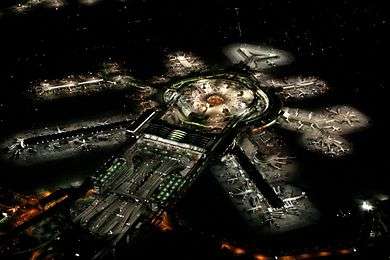
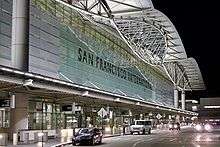
A $1 billion international terminal opened in December 2000, replacing Terminal 2.[16] This terminal has an aviation museum and library as part of the Louis A. Turpen Aviation Museum.[41] SFO’s long-running program of cultural exhibits, now called SFO Museum, won unprecedented accreditation by the American Alliance of Museums in 1999.[42]
A long-planned extension of the BART system to the airport opened on June 22, 2003, allowing passengers to board BART trains at the international terminal and have direct rail transportation to downtown San Francisco, Oakland and the East Bay.[43] On February 24, 2003, the AirTrain people mover opened, transporting passengers between terminals, parking lots, the BART station, and the rental car center on small automatic trains.
SFO experiences delays (known as flow control) in overcast weather when only two of the airport's four runways can be used at a time because the centerlines of the parallel runways are only 750 feet (230 m) apart. Airport planners have floated proposals to extend the airport's runways into San Francisco Bay to accommodate arrivals and departures during low visibility. To expand into the bay the airport would be required by law to restore bay land elsewhere in the Bay Area to offset the fill. Such proposals have met resistance from environmental groups, fearing damage to the habitat of animals near the airport, recreational degradation (such as windsurfing) and bay water quality. Such delays (among other reasons) caused some airlines, especially low-cost carriers such as Southwest Airlines, to shift all of their service from the airport to Oakland and San Jose. However, Southwest eventually returned to SFO in 2009.[44]
SFO has become the base of operations for start-up airline Virgin America, with service to over 15 destinations. On October 4, 2007, an Airbus A380 jumbo jet made its first visit to SFO.[45] On July 14, 2008 SFO was voted Best International Airport in North America for 2008 in the World Airports Survey by Skytrax.[46] The following year on June 9, Skytrax announced SFO as the second-best International Airport in North America in the 2009 World Airports Survey, losing to Dallas/Fort Worth International Airport.[47]
The FAA has warned that the airport's control tower would be unable to withstand a major earthquake and has requested that it be replaced. On July 9, 2012, crews broke ground for the airport's new air traffic control tower. The new tower, between terminals 1 and 2, is shaped like a torch and will be completed in the summer of 2016 at a cost of $102 million.[48]
SFO was one of several US airports that operated the Registered Traveler program from April 2007 until funding ended in June 2009. This program let travelers who had paid for pre-screening pass through security checkpoints quickly.[49][50] Baggage and passenger screening is operated by Covenant Aviation Security, a TSA contractor, nicknamed "Team SFO." SFO was the first airport in the United States to integrate in-line baggage screening into its baggage-handling system and has been a model for other airports in the post-9/11 era.
Runways
The airport covers 5,207 acres (21.07 km2) at an elevation of 13.1 feet (4.0 m).[2] It has 4 asphalt runways:
- Runway 1L/19R: 7,650 x 200 ft (2,332 x 61 m.), Surface: Asphalt, has approved GPS approaches
- Runway 1R/19L: 8,650 x 200 ft (2,637 x 61 m.), Surface: Asphalt, ILS/DME equipped, and has approved GPS/VOR approaches
- Runway 10L/28R: 11,870 x 200 ft (3,618 x 61 m.), Surface: Asphalt, ILS/DME equipped, and has approved GPS approaches
- Runway 10R/28L: 11,381 x 200 ft (3,469 x 61 m.), Surface: Asphalt, ILS/DME equipped, and has approved GPS approaches [2]
Runway Safety Area Construction
In the summers of 2013 and 2014, the runways shut down in pairs to work on improvements to the runway safety areas.
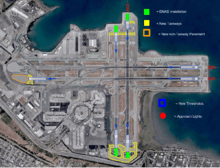
Improvements made were...
- Extending the runway thresholds
- Taxiway reconstruction
- Installation of an EMAS on runways 1L-19R and 1R-19L[51]
Aircraft noise abatement
SFO was one of the first airports to implement a Fly Quiet Program, which grades airlines on their performance on noise abatement procedures while flying in and out of SFO. The Jon C. Long Fly Quiet Program[52] was started by the Aircraft Noise Abatement Office to encourage airlines to operate as quietly as possible at SFO.
SFO was one of the first U.S. airports to conduct a residential sound abatement retrofitting program. Established by the FAA in the early 1980s, this program evaluated the cost effectiveness of reducing interior sound levels for homes near the airport, within the 65 CNEL noise contour. The program made use of a noise computer model to predict improvement in specific residential interiors for a variety of noise control strategies. This pilot program was conducted for a neighborhood in South San Francisco and success was achieved in all of the homes analyzed. The costs turned out to be modest, and the post-construction interior sound level tests confirmed the predictions for noise abatement. To date over $153 million has been spent to insulate more than 15,000 homes in the neighboring cities of Daly City, Pacifica, San Bruno, and South San Francisco.[53]
Terminals

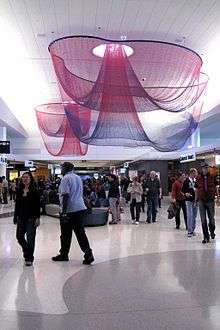

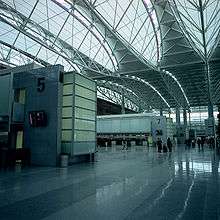
The airport has four terminals (1, 2, 3, and International) and seven concourses (Boarding Areas A through G) arranged alphabetically in a counterclockwise ring. Terminal 1 (Boarding Areas B and C), Terminal 2 (Boarding Area D), and Terminal 3 (Boarding Areas E and F) handle domestic flights (including precleared flights from Canada). The International Terminal (Boarding Areas A and G) handle international flights and some domestic flights.
Airside connectors
There exist two airside connectors at SFO that enable passengers to roam (post-security) between adjacent terminal buildings. A short airside connector links T3's Boarding Area F (adjacent to Amex Centurion Lounge) to the International Terminal Boarding Area G.[54] An airy 500-foot[55] airside connector links T1's Boarding Area C to T2.[56]
At present, there are no airside connectors between: T1 and International Boarding Area A; T2 and T3; International Boarding Areas A and G (the main terminal area of the International Terminal separates the two boarding areas). By approximately 2020 to 2022, the demolition and rebuild of the southern portion of T1 (Boarding Area B) will have been completed and an airside connector to International Boarding Area A will be added.[57]
Terminal 1
Formerly known as the "South Terminal," Terminal 1 is composed of Boarding Area B that has 24 gates (gates 20-23, 24A-B, 25-31, 32A-C, 33-35, 36A-B, 37-39) and Boarding Area C that has 10 gates (gates 40-44, 45A-B, and 46-48). A third boarding area, Rotunda A, was demolished in 2007. The first version of the terminal, which cost $14 million,[58] opened in 1963 and Rotunda A opened in 1974. The terminal was designed by Welton Becket and Associates.[59] The terminal underwent a $150 million renovation designed by Howard A. Friedman and Associates,[60] Marquis Associates and Wong & Brocchini[61] that was completed in 1988. Beginning in late 2015, Terminal 1 will be rebuilt in a $2.4-billion project to modernize the concourse and add gates.[62] The multi-phase project will yield a total of 24 gates when complete in 2024 (the existing Boarding Area A has less than 20 usable gates), including a secure FIS connector to the existing customs facilities in the International Terminal.[63] This will effectively add two new gates that can handle international arrivals.
Terminal 2
Terminal 2, formerly known as the "Central Terminal," opened in 1954 as the main airport terminal. After a drastic rebuilding designed by Gensler, it replaced Rotunda A as SFO's international terminal in 1983[64][65] and was closed for indefinite renovation when the current international terminal opened in 2000. Its only concourse is Boarding Area D that has 14 gates (gates 50, 51A, 51B, 52, 53, 54A, 54B, 55, 56A, 56B, 57, 58A, 58B, 59). The control tower and most operations offices were (and still are) located on the upper levels, and the departure and arrival areas served as walkways between Terminal 1 and Terminal 3.
On May 12, 2008, a $383 million renovation project was announced that included a new control tower, the use of green materials, and a seismic retrofit.[66] The newly renovated terminal also designed by Gensler features permanent art installations from Janet Echelman, Kendall Buster, Norie Sato, Charles Sowers, and Walter Kitundu.[64][67] Terminal 2 set accolades by being the first U.S. airport to achieve LEED Gold status.[68] The terminal reopened on April 14, 2011, with Virgin America and American Airlines sharing the new 14-gate common-use facility.[69] Terminal 2 also hosts an Admirals Club.
Terminal 3
Formerly known as the "North Terminal," Terminal 3 has Boarding Area E has 10 gates (gates 60–69) and Boarding Area F has 29 gates (gates 70, 71A-B, 72-76, 73A, 77A-C, 78-83, 84A-D, 85-90, and 87A). This $82.44 million terminal designed by San Francisco Airport Architects (a joint venture of John Carl Warneeke and Associates, Dreyfus and Blackford, and minority architects)[70] is used for United Airlines' domestic flights. Mainline United flights use both boarding areas, while United Express regional flights use Boarding Area F.[71] Boarding Area F opened in 1979 and Boarding Area E opened in 1981. American Airlines[72] and Air Canada[73] occupied Boarding Area E until it closed for refurbishment in 2011. It reopened on January 28, 2014.[74] The project moved one (1) gate from Boarding Area F on to Boarding Area E to provide a total of ten aircraft parking positions.[75] As part of the airport's FY 2010/11 – FY 2014/15 Capital Plan, Terminal 3 will be renovated. This renovation includes architectural enhancements, structural renovations, replacement of HVAC systems, roof repair, and new carpeting.[76] There is a United Club in Terminal 3 near the rotunda for Boarding Area F and a temporary United Club on the Mezzanine level (post-security) between Boarding Areas E and F. Terminal 3 also houses the American Express Centurion Lounge, located across from Gate 74.
International terminal
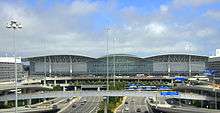
The International Terminal is composed of Boarding Areas A and G. The terminal was designed by Craig W. Hartman of Skidmore, Owings and Merrill and opened in December 2000 to replace the International Departures section of Terminal 2. It is the largest international terminal in North America, and is the largest building in the world built on base isolators to protect against earthquakes.[77] Food service focuses on quick service versions of leading San Francisco Bay Area restaurants, following other SFO terminals. Planners attempted to make the airport a destination in and of itself, not just for travelers who are passing through.[78] The international terminal is a common use facility, with all gates and all ticketing areas shared among the international airlines. All international arrivals and departures are handled here (except flights from cities with customs preclearance). The International Terminal also contains the airport's BART station, adjacent to the garage leading to Boarding Area G. The SFO Medical Clinic is located next to the security screening area of Boarding Area A. All the gates in this terminal have at least two jetway bridges except gates A2 and A10, which have one. Gates A1, A3, and A11 can accommodate two aircraft. Six of the gates are designed for the Airbus A380, making SFO one of the first airports in the world with such gates when it was built in 2000.[79] Gates A9 (9A, 9B, 9C) and G101 (101A, 101B, 101C) have three jetways for boarding.[80] Four other gates have two jetways fitted for A380 service.[80]
As of April 2015, Air France, British Airways, Emirates, and Lufthansa operate the Airbus A380 into SFO which is the largest commercial passenger jetliner in the world. Singapore Airlines once operated the A380 from SFO, but now currently uses the Boeing 777-300ER for their service to Singapore-Changi via Seoul or Hong Kong.
The airport had to build the terminal on top of the main access road, at enormous expense, completing the continuous ring of terminals. The terminal required its own set of ramps to connect it with Highway 101. The design and construction of the international terminal was by Skidmore, Owings & Merrill, Del Campo & Maru Architects, Michael Willis Associates, and built by Tutor Perini (main terminal building), Hellmuth, Obata and Kassabaum in association with Robin Chiang & Company, Robert B. Wong Architects, and built by Tutor Perini (Boarding Area G), and Gerson/Overstreet Architects and built by Hensel Phelps Construction (Boarding Area A).[77] The contracts were awarded after an architectural design competition.
International flights operated Star Alliance carriers, with some exceptions, are assigned to Boarding Area G's 15 gates (G91, G92–G92A, G93–G98, G99–G99A, G100, G101–G101A, G102) and three remote parking stands.[81] Exceptions include: Asiana Airlines and Avianca El Salvador, which have been designated Boarding Area A; and non-aligned carrier Aer Lingus, which utilizes this boarding area. All of United's international flights and select domestic flights board and deplane at Boarding Area G. When all gates in an airlines' designated international boarding area are full, the passengers will board or deplane from the opposite international boarding area.
International flights operated by SkyTeam, Oneworld and non-aligned international carriers, with some exceptions, board and deplane at Boarding Area A's 13 gates (gates A1–A10, A11–A11A, A12). Some exceptions to this include: Star Alliance carriers Asiana Airlines and Avianca El Salvador, both of which operate out of this boarding area; and non-aligned carrier Aer Lingus which has a designated gate located at Boarding Area G. Additionally, Boarding Area A is used by domestic carriers Alaska Airlines, JetBlue Airways, Sun Country Airlines, and Hawaiian Airlines.
Air Canada, Aer Lingus, Etihad Airways, and WestJet are international air carriers operating from airports with United States border preclearance, allowing arriving passengers to skip the wait at customs and immigration when they arrive at SFO, and exit the airport from the departure level.
The two main designations for the International Terminal are "I", and "INTL" (abbreviations for "International"). Oftentimes travel itineraries will say "T-I", and this has led to instances where passengers misinterpret the "I" as Terminal 1, especially since both Boarding Area A and Boarding Area G are used for a limited number of domestic flights.
Airlines and destinations



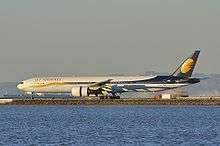
.jpg)

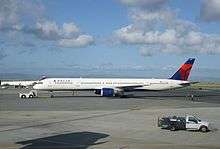
.jpg)
.jpg)
.jpg)
.jpg)
- Note: All international arrivals (except for flights from cities with U.S. customs preclearance) are handled at the International Terminal (Boarding Areas A and G), regardless of departure terminal.
Passenger
Cargo
Statistics
Top destinations
| Rank | City | Passengers | Top carriers |
|---|---|---|---|
| 1 | Los Angeles, California | 1,834,000 | American, Delta, Southwest, United, Virgin America |
| 2 | New York–JFK, New York | 1,199,000 | American, Delta, JetBlue, United, Virgin America |
| 3 | Chicago–O'Hare, Illinois | 1,189,000 | American, Frontier, United, Virgin America |
| 4 | Las Vegas, Nevada | 1,034,000 | JetBlue, Southwest, United, Virgin America |
| 5 | Seattle/Tacoma, Washington | 996,000 | Alaska, Delta, United, Virgin America |
| 6 | Newark, New Jersey | 771,000 | United, Virgin America |
| 7 | Denver, Colorado | 768,000 | Frontier, Southwest, United |
| 8 | San Diego, California | 767,000 | Southwest, United, Virgin America |
| 9 | Dallas/Fort Worth, Texas | 641,000 | American, United |
| 10 | Phoenix, Arizona | 637,000 | American/US Airways, Frontier, Southwest, United |
| Rank | Airport | Passengers | Change 2013/2014 |
Carriers |
|---|---|---|---|---|
| 1 | London (Heathrow), United Kingdom | 911,760 | |
British Airways, United, Virgin Atlantic |
| 2 | Hong Kong, Hong Kong | 821,286 | |
Cathay Pacific, Singapore Airlines, United |
| 3 | Taipei (Taoyuan), Taiwan | 715,780 | |
China Airlines, EVA Air, United |
| 4 | Seoul (Incheon), South Korea | 711,003 | |
Asiana, Korean Air, Singapore Airlines, United |
| 5 | Frankfurt, Germany | 648,658 | |
Lufthansa, United |
| 6 | Vancouver, Canada | 592,294 | |
Air Canada, United, WestJet |
| 7 | Tokyo (Narita), Japan | 542,925 | |
All Nippon, United |
| 8 | Paris (Charles de Gaulle), France | 447,623 | |
Air France, United, XL Airways |
| 9 | Toronto (Pearson), Canada | 411,261 | |
Air Canada |
| 10 | Beijing (Capital), China | 408,491 | |
Air China, United |
| Year | Rank | Passengers | Change | Aircraft movements | Cargo (tonnes) |
|---|---|---|---|---|---|
| 1998 | 40,101,387 | 432,046 | 598,579 | ||
| 1999 | 40,387,538 | | 438,685 | 655,409 | |
| 2000 | 9 | 41,048,996 | | 429,222 | 695,258 |
| 2001 | 14 | 34,632,474 | | 387,594 | 517,124 |
| 2002 | 19 | 31,450,168 | | 351,453 | 506,083 |
| 2003 | 22 | 29,313,271 | | 334,515 | 483,413 |
| 2004 | 21 | 32,744,186 | | 353,231 | 489,776 |
| 2005 | 23 | 33,394,225 | | 352,871 | 520,386 |
| 2006 | 26 | 33,581,412 | | 359,201 | 529,303 |
| 2007 | 23 | 35,790,746 | | 379,500 | 503,899 |
| 2008 | 21 | 37,402,541 | | 387,710 | 429,912 |
| 2009 | 20 | 37,453,634 | | 379,751 | 356,266 |
| 2010 | 23 | 39,391,234 | | 387,248 | 384,179 |
| 2011 | 22 | 41,045,431 | | 403,564 | 340,766 |
| 2012 | 22 | 44,477,209 | | 424,566 | 337,357 |
| 2013 | 22 | 44,944,201 | | 421,400 | 325,782 |
| 2014 | 21 | 47,074,162 | | 431,633 | 349,585 |
| 2015 | 15 | 33,346,285 | | 285,486 | 308,731 |
Ground transportation
AirTrain
AirTrain is the airport's people-mover system. Fully automated and free of charge, it connects all four terminals, the two international terminal garages, the BART station, and the airport's Rental Car Center.[101]
Rail
BART
The San Francisco International Airport (SFO) BART station, located in Parking Garage G of the International Terminal, is the only direct rail link between the airport, the city of San Francisco, and the general Bay Area. As of September 14, 2009, the SFO station is served by the Pittsburg/Bay Point – SFO/Millbrae line.
Caltrain
BART is SFO's connection to Caltrain at the Millbrae Station, which requires a transfer at the San Bruno station during most of BART's weekday operating hours; direct service between SFO and Millbrae is available on weekday evenings, weekends, and holidays.[102] Caltrain used to offer a free shuttle to SFO airport from the Millbrae station,[103] but it was replaced by BART service when the SFO extension was completed.
Bus
The San Francisco Municipal Railway, San Francisco's transit agency, does not provide service to the airport. However, SamTrans, San Mateo County's transit agency, does, with five lines, 140, 292, 397, 398, and KX, connecting the Airport with Downtown San Francisco, the Peninsula, and as far south as Palo Alto. In particular:
- Route 140 provides local service from the Rental Car Center (accessible via AirTrain) to San Bruno, South San Francisco, and Pacifica, stopping at San Bruno Caltrain, San Bruno BART, and Skyline College for connections within San Mateo County and beyond.
- Route 292 serves the airport daily between San Francisco and Hillsdale Mall via Bayshore Boulevard and Downtown San Mateo.
- Route KX provides express service to the airport from Redwood City (northbound) during the morning commute and from San Francisco (southbound) during the afternoon and evening commute.
- Route 398 serves the airport when Route KX does not operate, and it runs between San Bruno BART and Redwood City Caltrain. This route operates daily except during certain times at peak periods on weekdays.
- Route 397 operates to the airport during the overnight hours as a part of the Bay Area's "All Nighter" service.[104] This service mirrors that of Route 292 north of the airport (with an additional stop at Civic Center BART/Muni Metro Station), with service continuing south via Millbrae BART/Caltrain Station and El Camino Real to and from Palo Alto Caltrain.
Samtrans can be accessed on the arrivals/baggage claim level of the domestic terminals and in courtyard A or G in the International Terminal.
Numerous door-to-door "shared ride" van and hotel courtesy shuttles stop at the center transportation island on the departure level, while airporter and limousine are on the arrivals/baggage claim level of the airport. Charter services are also available in the courtyards.
Car

The airport is located on U.S. Route 101, 13 miles (21 km) south of downtown San Francisco. It is near the US 101 interchange with Interstate 380, a short freeway that connects US 101 with Interstate 280.
The airport provides both short-term and long-term parking facilities.
Short term parking is located in the central terminal area and two international terminal garages. Long term parking is located on South Airport Blvd. and San Bruno Ave. and are served by shuttle buses.[105]
Passengers can also park long-term at a select number of BART stations that have parking lots, with a permit purchased online in advance.[106]
Taxi
Taxis depart from designated taxi zones located at the roadway center islands, on the Arrivals/Baggage Claim Level of all terminals.[107]
Ride share services (or transportation network companies) such as Lyft, Uber, and Sidecar are available via their respective mobile app and can be picked up at the curbside of the each terminal's departure level.
Other facilities
Currently Nippon Cargo Airlines has its San Francisco branch on the airport property.[108]
Prior to its dissolution, Pacific Air Lines had its corporate headquarters on the grounds of the airport.[109] Prior to its dissolution, Hughes Airwest also had its headquarters on the grounds of the airport.[110]
Accidents and incidents
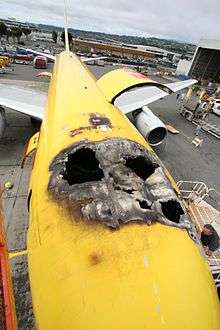
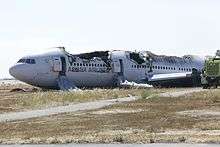
- On February 9, 1937, a United Airlines Douglas DC-3A-197[111] transport liner circled the airport, then crashed into the bay, killing 11 people.[112]
- On September 12, 1951, United Airlines Flight 7030[113] plunged into the bay during a training exercise killing all three crew members.
- On October 29, 1953, British Commonwealth Pacific Airlines flight 304,[114] a Douglas DC-6 en route from Sydney, Australia, with fuel stops in Auckland, New Zealand, Fiji, and Honolulu, crashed on approach to SFO into Kings Mountain in San Mateo County. All 19 passengers and crew members died.
- On February 20, 1959, a Pan American DC-7C[115] crashed and burned on the runway. The three crew members on board survived.
- On February 3, 1963, Slick Airways Flight 40[116] crashed and burned after striking approach lights on runway 28R, killing the four people on board.
- On December 24, 1964, Flying Tiger Line Flight 282, a Lockheed Constellation cargo aircraft departing for New York City, crashed in the hills west of the airport, killing all three crew members on board.[117]
- On June 28, 1965, Pan Am Flight 843, a Boeing 707, had just departed for Honolulu, Hawaii, when its #4 engine exploded, causing part of the wing and the engine itself to break off and fall into the streets below. The crew were able to extinguish the ensuing fire and land safely at the nearby Travis Air Force Base.
- On November 22, 1968, a Japan Air Lines DC-8, named the Shiga, operating Flight 2, crash-landed on final approach at 9:30 a.m. on a shallow submerged reef at the eastern tip of Coyote Point (three miles short of the runway southeast of the airport). The plane was on a trip from Tokyo to San Francisco, after making a stop in Honolulu. The pilot was experienced, but apparently misread the instruments on the DC-8, which was less than a year old. There were 107 people on the plane. There were no deaths or serious injuries. The plane was salvaged by Bigge Drayage Company soon after the crash. All luggage and fuel were removed to cut the weight and the plane was lifted onto a barge and taken to the airport for repairs. The cost of repairs was $4 million and the plane re-entered service the following April.
- On July 30, 1971, Pan Am Flight 845, a Boeing 747 (registration: N747PA, name: Clipper America), struck navigational aids at the end of runway 1R on takeoff for Tokyo. The aircraft's landing gear and other systems were damaged. Two passengers were seriously injured by metal components of the runway approach light pier entering the cabin. The flight proceeded out over the Pacific Ocean to dump fuel to reduce weight for an emergency landing. Emergency services deployed at the airport, and the plane returned and landed on runway 28R. During landing the aircraft veered off the runway. There was no fire. After coming to a stop, the aircraft slowly tilted aft, coming to rest on its tail in a nose-high attitude. The forward evacuation slides were therefore in a nearly vertical position. Evacuation using these slides caused all of the additional injuries, some severe. There were no fatalities among the 218 passengers and crew members aboard. An investigation determined that the cause of the accident was erroneous information from the flight dispatcher to the crew members regarding weight and runway length.[118]
- On September 13, 1972, TWA Flight 604,[119] a Boeing 707-331C cargo plane crashed into the bay on takeoff. All three crew members survived.
- On February 19, 1985, China Airlines Flight 006 (callsign "Dynasty 006") flying from Taipei's Taiwan Taoyuan International Airport, then Chiang Kai Shek International Airport, to Los Angeles International Airport, was involved in an aircraft upset accident after the No. 4 engine flamed out. The plane rolled over and plunged 30,000 ft (9,100 m), experiencing high speeds and g-forces (approaching 5g) before the captain was finally able to recover from the rapid dive, and then to divert to San Francisco International Airport. All 251 passengers and 23 crew members survived, though there were 24 injuries, two of which were serious.
- Of the four aircraft hijacked in the September 11 attacks, one—United Airlines Flight 93 from Newark Liberty International Airport, which was hijacked over northwestern Pennsylvania—was destined for San Francisco. Authorities believe the hijackers intended to fly into the White House or Capitol Building, but the passengers overpowered the hijackers and the plane crashed into a field in Shanksville, Pennsylvania.
- On June 28, 2008, an ABX Air Boeing 767 preparing to depart with cargo caught fire and was seriously damaged. The pilots escaped uninjured. The airline had received a threat the week before, but thus far investigations have revealed no evidence of any malicious device on board.[120]
- On July 6, 2013, Asiana Airlines Flight 214, a Boeing 777-200ER registered HL7742, crashed while landing. The tail section of the aircraft struck the seawall at the end of the runway, and became detached from the airframe, the plane ended up 2,000 feet (600 meters) down the runway. Passengers and crew members evacuated before fire, due to ignited engine lubricating oil, destroyed the aircraft. There were three fatalities, making this the first fatal Boeing 777 crash.[121][122][123][124][125][126][127]
In popular culture
- The climax of the Steve McQueen movie Bullitt was filmed at the airport.[128] Jet aircraft operated by Pacific Southwest Airlines (a PSA Boeing 727) and Pan American World Airways (a Pan Am Boeing 707) were prominently featured in the scenes filmed at SFO.
- The short-lived television series San Francisco International Airport (1970) was set at the airport.
- In the Dale Brown novel Storming Heaven, the airport is subject to a massive terror attack.
- The airport was used as a location of the beginning of the movie Homeward Bound II: Lost in San Francisco.
- The opening and closing scenes of What's Up Doc (Barbra Streisand, Ryan O'Neal - 1972) were filmed in the departure / ticket and baggage claim areas of what was known as the South Terminal (now Terminal 1)
- Dirty Harry foils a hijacking at the airport in 1973's Magnum Force.
- The airport was featured in the 2004 video game Grand Theft Auto: San Andreas as Easter Bay International Airport.
- The destination of the principal aircraft in the film The High and the Mighty, a Douglas DC-4, is the airport. The film's climax takes place there, but was filmed in Burbank, California.
- The airport stood in for Honolulu International Airport in the 2014 movie Godzilla.
See also
- List of airports in California
- Transportation in the San Francisco Bay Area
- California World War II Army Airfields
References
- ↑ "SFO – San Francisco International Airport". flySFO.com. San Francisco International Airport. Retrieved August 3, 2009.
- 1 2 3 FAA Airport Master Record for SFO (Form 5010 PDF), effective December 20, 2007
- ↑ "San Francisco International Airport". Geographic Names Information System. United States Geological Survey. Retrieved May 3, 2009.
- 1 2 "Airports Council International - Worldwide Airport Traffic Report - Calendar Year 2013" (PDF). The Port Authority of NY & NJ.
- ↑ "About Us". Virgin America. Archived from the original on September 25, 2009. Retrieved August 3, 2009.
- ↑ Smith, Matt (March 28, 2001). "Flying Blind". SF Weekly. Retrieved August 3, 2009.
- ↑ "Financial Audits". City and County of San Francisco. January 22, 2007. Retrieved August 3, 2009.
- ↑ "SFO Enterprises, Inc.". SF Weekly. Retrieved August 3, 2009.
- ↑ The Shock Doctrine, Naomi Klein; pg. 396.
- ↑ "negative: Mills Field Municipal Airport of San Francisco". SFO Museum. May 7, 1927. Retrieved November 10, 2015.
- ↑ United Airlines timetables: June 15, 1931; June 20, 1933; June 1, 1935; February 1, 1937; June 1, 1937. Airline Timetable Images. Retrieved 2009-09-12.
- ↑ "Pacific Seaboard Air Lines". Airline Timetable Images. Summer 1933. Retrieved August 28, 2015.
- ↑ "Family". Delta Flight Museum. Retrieved August 28, 2015.
- 1 2 "Delta Air Lines system timetable". February 1, 1962. Retrieved August 28, 2015.
- ↑ The Daily Journal, July 1, 2013
- 1 2 Wilson, Marshall (December 4, 2000). "A Guide to the New International Wing". San Francisco Chronicle (Hearst Communications). pp. A–1. Retrieved August 3, 2009.
- ↑ "American Airlines" (PDF). 1960s Airline & Airliner Antiques. January 3, 1960. Retrieved August 28, 2015.
- ↑ "Western Airlines system timetable". Airline Timetable Images. September 6, 1960. Retrieved August 28, 2015.
- ↑ "SFO Helicopter Airlines". Airline Timetable Images. September 1, 1961. Retrieved August 28, 2015.
- ↑ "SFO Helicopter Airlines". Airline Timetable Images. October 26, 1975. Retrieved August 28, 2015.
- ↑ "National Airlines". Airline Timetable Images. March 2, 1962. Retrieved August 28, 2015.
- ↑ "PSA - Pacific Southwest Airlines". Airline Timetable Images. June 25, 1962. Retrieved August 28, 2015.
- 1 2 "PSA History". Pacific Southwest Airlines History Page. Retrieved August 28, 2015.
- ↑ "British Commonwealth Pacific Airlines". Airline Timetable Images.
- ↑ "Qantas Timetable". Airline Timetable Images. November 6, 1959. Retrieved August 28, 2015.
- ↑ "BOAC system timetable". Airline Timetable Images. April 24, 1960. Retrieved August 28, 2015.
- ↑ "BOAC system timetable". Airline Timetable Images. August 1, 1961. Retrieved August 28, 2015.
- ↑ "Japan Airlines system timetable". Airline Timetable Images. December 1, 1961. Retrieved August 28, 2015.
- ↑ "Lufthansa system timetable". Airline Timetable Images. April 1, 1961. Retrieved August 28, 2015.
- ↑ "Lufthansa system timetable". Airline Timetable Images. January 1, 1963. Retrieved August 28, 2015.
- ↑ "Panagra system timetable". Airline Timetable Images. August 1, 1965. Retrieved August 28, 2015.
- ↑ "Braniff International system timetable". Airline Timetable Images. July 1, 1968. Retrieved August 28, 2015.
- ↑ "CP Air system timetable". Airline Timetable Images. July 15, 1970. Retrieved August 28, 2015.
- ↑ "Southwest Airways - The Pacific Air Line system timetable". Airline Timetable Images. April 28, 1957. Retrieved August 28, 2015.
- ↑ "Pacific Air Lines system timetable". Airline Timetable Images. July 1, 1959. Retrieved August 28, 2015.
- ↑ "Pacific Air Lines route map". AirTimes - A Source for Airline History. July 20, 1966. Retrieved August 28, 2015.
- ↑ http://www.departedflights.com, April 28, 1968 West Coast Airlines route map
- ↑ http://www.departedflights.com, January 15, 1978 Hughes Airwest route map
- ↑ Roderick, Kevin (October 19, 1989). "Search For Bodies to Take Days—State Puts Toll at 273, Then Says It Is Uncertain". Los Angeles Times. Retrieved September 5, 2009.
- ↑ Environmental Impact Report for the San Francisco International Airport Master Plan (Report). Earth Metrics Inc. and Jefferson Associates, prepared for the city of San Francisco and California State Clearinghouse. 1989.
- ↑ "San Francisco Airport Commission Aviation Library & Louis A. Turpen Aviation Museum". SFO Museum. San Francisco Airport Commission. November 10, 2015. Retrieved November 10, 2015.
- ↑ "San Francisco Airport Commission Aviation Library & Louis A. Turpen Aviation Museum - Mission Statement and History". SFO Museum. San Francisco Airport Commission. November 10, 2015. Retrieved November 10, 2015.
- ↑ Cabantuan, Michael (June 22, 2003). "History is Here – New Line Creates Transit Hub, Link to Future". San Francisco Chronicle (Hearst Communications). pp. A–1. Retrieved August 3, 2009.
- ↑ "Press Room, Our History, Openings/Closings". Southwest Airlines. Retrieved August 28, 2015.
- ↑ Raine, George (October 5, 2007). "Airbus Jumbo Jet Makes Test Landing at SFO". San Francisco Chronicle (Hearst Communications). pp. C–1. Retrieved August 3, 2009.
- ↑ "Airport of the Year 2008: Regional Results". Airport of the Year 2008. Skytrax Research. July 28, 2008. Archived from the original on July 30, 2008. Retrieved August 3, 2009.
- ↑ "Airport of the Year 2009: Regional Results". Airport of the Year 2009. Skytrax Research. June 9, 2009. Archived from the original on May 29, 2010. Retrieved September 9, 2009.
- ↑ "New SFO control tower will have a torch-like air". Retrieved May 11, 2015.
- ↑ "Getting Through Airport Security with CLEAR". On the Ground Travel. December 11, 2012. Retrieved January 31, 2013.
- ↑ "Clear Lanes Are No Longer Available". Clear. Verified Identity Pass, Inc. June 25, 2009. Retrieved August 3, 2009.
- ↑ "Runway Safety Areas". FlySFO.com. San Francisco International Airport. Retrieved 1 January 2016.
- ↑ "Fly Quiet Program - Jon C. Long Fly Quiet Awards". flySFO.com. San Francisco International Airport. Retrieved August 28, 2015.
- ↑ "Residential Sound Insulation Program". SFO – Aircraft Noise Abatement Office. BridgeNet International. September 1, 2009. Archived from the original on December 24, 2009. Retrieved September 12, 2009.
- ↑ "Connecting at San Francisco - Airport Maps and Connections - Check-In & Immigration". Air New Zealand. 2013-10-08. Retrieved 2015-12-17.
- ↑ McGinnis, Chris (2014-11-19). "New "secret passageway" at SFO - Chris McGinnis". Web.archive.org. Archived from the original on September 9, 2015. Retrieved 2015-12-17.
- ↑ "New options for Delta flyers at SFO - TravelSkills". Web.archive.org. 2014-11-12. Archived from the original on March 16, 2015. Retrieved 2015-12-17.
- ↑ https://web.archive.org/web/20151031131927/http://sfgov.org/arts/sites/sfgov.org.arts/files/SFO_T1_Presentation_031615.pdf
- ↑ "San Francisco Public Library - Bay Region Business". Archive.org. Retrieved 2013-07-06.
- ↑ "Projects Slated at SF Airport". Los Angeles Times. July 13, 1958. Retrieved June 14, 2012.
- ↑ Friedman, Howard A.; Reitherman, Robert. Successful Architecture: Selected Works and Thought of Howard A. Friedman. H. Friedman Family. p. 66. Retrieved June 14, 2012.
- ↑ "Tabular LT Institutional Facilities" (PDF). Retrieved 2013-07-06.
- ↑ "Terminal 1 Redevelopment". flySFO.com. San Francisco International Airport. Retrieved August 28, 2015.
- ↑ "CMAA Terminal 1 Redevelopment Program" (PDF). November 29, 2012. Retrieved August 28, 2015.
- 1 2 McCarthy, Allison (April 4, 2011). "A First Look at SFO's New Terminal 2". 7x7.com. Retrieved 2013-07-06.
- ↑ San Francisco International Airport Competition Plan (PDF) (Report). San Francisco International Airport. August 8, 2000. Archived from the original (PDF) on May 18, 2011. Retrieved July 14, 2013.
- ↑ Manekin, Michael (July 8, 2008). "SFO Brings Ghost Terminal Back From the Dead". San Mateo County Times (Bay Area News Group). Retrieved August 3, 2009.
- ↑ "Five New Public Artworks to Debut at San Francisco International Airport’s New Terminal 2". Sfartscommission.org. Retrieved 2013-07-06.
- ↑ Defence Security Report
- ↑ "SFO's renovated Terminal 2 is set to open April 14 and will house Virgin America and American Airlines". ABC7 News KGO-TV (San Francisco, California). February 10, 2011. Retrieved July 6, 2013.
- ↑ "Airport Undergoes Marathon Expansion". Engineering News-Record (McGraw-Hill) 200 (1): 18. 1978.
- ↑ "Airlines at SFO". flySFO.com. San Francisco International Airport. Retrieved August 28, 2015.
- ↑ "American to Relocate Operations at SFO to New Terminal 2". Airlinesanddestinations.com. 2010-09-08. Retrieved 2015-12-17.
- ↑ http://www.flysfo.com/sites/default/download/about/commission/agenda/pdf/minutes/m030111.pdf
- ↑ Yakel, Doug (January 24, 2014). "Join the E-Volution - SFO Re-Opens Boarding Area E" (Press release). San Francisco International Airport. Retrieved January 24, 2014.
- ↑ "San Francisco International Airport Boarding Area E". City and County of San Francisco. March 19, 2012. Retrieved January 31, 2013.
- ↑ FY14/15 Five-Year Capital Plan (PDF) (Report). San Francisco International Airport. Archived from the original (PDF) on October 14, 2012. Retrieved January 31, 2013.
- 1 2 "Fact Sheet – International Terminal" (PDF). flySFO.com. San Francisco International Airport. January 30, 2007. Archived from the original (PDF) on May 21, 2009. Retrieved August 3, 2009.
- ↑ Armstrong, David (October 7, 2003). "Terminal Gastronomy – New Plan Brings Icons of the Bay Area's Food-Loving Culture to the S.F. Airport". San Francisco Chronicle (Hearst Communications). pp. B–1. Retrieved August 3, 2009.
- ↑ Armstrong, David (July 15, 2004). "Super-Size Skies – SFO Says It's Ready for a 555-Person Plane Arriving in 2006". San Francisco Chronicle (Hearst Communications). pp. C–1. Retrieved August 3, 2009.
- 1 2 "A380 at SFO". May 9, 2011. Retrieved March 21, 2013.
- ↑ https://web.archive.org/web/20151015132731/http://www9.passur.com/sfo_docs/sfopdf4.pdf
- ↑ airberlin Proposes New Dusseldorf Long-Haul Service from May 2016. Airline Route. November 11, 2015. Retrieved November 11, 2015.
- ↑ "Air Canada Unveils Major Expansion to 12 U.S. Destinations". Air Canada. November 19, 2015. Retrieved November 19, 2015.
- ↑ "Fiji Airways Adds Seasonal San Francisco Flights June – August 2016". Airlineroute.net.
- ↑ "Frontier launching new Atlanta routes - AJC@ATL". Airport Blog AJC.
- 1 2 Harriet Baskas, Special for USA TODAY (January 7, 2016). "Frontier Airlines announces 42 new routes". USA TODAY.
- 1 2 3 "United Airlines Made SFO the Best Pacific Hub. And Then Found 3 Ways to Make it Better. - Oct 8, 2015". Newsroom.united.com. Retrieved 2015-12-17.
- ↑ "UNITED Adds San Francisco – Nashville Service from May 2016". AirlineRoute.net. December 15, 2015. Retrieved December 15, 2015.
- ↑ http://finance.yahoo.com/news/united-airlines-operate-longest-scheduled-010000485.html;_ylt=AwrC1zE8v6pWp1IAeSTQtDMD;_ylu=X3oDMTByOHZyb21tBGNvbG8DYmYxBHBvcwMxBHZ0aWQDBHNlYwNzcg--
- ↑ JL (2015-11-18). "Virgin America Adds San Francisco – Denver Flights from March 2016". Airline Route. Retrieved 2015-12-17.
- ↑ "Wow Air Launches US West Coast Service from June 2016". Airlineroute.net.
- ↑ "ABX Air". Retrieved March 24, 2013.
- ↑ "Asiana Cargo Schedule". Retrieved August 28, 2015.
- ↑ "China Airlines Cargo Schedule". Retrieved March 27, 2013.
- ↑ "EVA Air Cargo Schedule" (PDF). p. 8. Retrieved May 23, 2013.
- ↑ "Korean Air Cargo". Retrieved March 22, 2013.
- ↑ "NCA Flight Schedule" (PDF). Nippon Cargo Airlines. Summer 2013. Retrieved June 29, 2013.
- ↑ "RITA | BTS | Transtats". Transtats.bts.gov. 2013-06-07. Retrieved Feb 2016.
- ↑ "U.S. International Air Passenger and Freight Statistics Report". Office of Aviation Analysis, U.S. Department of Transportation. 2015. Retrieved February 5, 2016.
- ↑ "Air Traffic Statistics". flySFO.com. San Francisco International Airport. Retrieved January 31, 2013.
- ↑ "Airtrain FAQ". flySFO.com. San Francisco International Airport. Retrieved August 3, 2009.
- ↑ "BART San Francisco Int'l Airport Station Schedule". San Francisco Bay Area Rapid Transit District. November 28, 2007. Retrieved December 31, 2009.
- ↑ SFO – Millbrae Caltrain Shuttle at the Wayback Machine (archived December 11, 2003)
- ↑ "Public Transit". flySFO.com. San Francisco International Airport. Retrieved August 3, 2009.
- ↑ "Parking at a Glance". flySFO.com. San Francisco International Airport. Retrieved August 28, 2015.
- ↑ "BART - Parking". Bart.gov. Retrieved 2013-07-06.
- ↑ "Taxi Pick-Up Locations". flySFO.com. San Francisco International Airport. Retrieved August 3, 2009.
- ↑ "America." Nippon Cargo Airlines. Retrieved on February 17, 2012. "900 North Access Road, San Francisco International Airport, San Francisco, CA 94128, U.S.A."
- ↑ Flight International. April 2, 1964. 523. "Head Office: International Airport, San Francisco, California."
- ↑ "World Airline Directory." Flight International. April 28, 1979. 1379. "Head Office: San Francisco International Airport, San Francisco, Ealif 94128, USA."
- ↑ "ASN Aircraft accident Douglas DC-3A-197 NC16073 San Francisco International Airport, CA (SFO)". Aviation Safety Network. February 9, 1937. Retrieved July 21, 2013.
- ↑ "Major SFO crashes". SFGate. July 6, 2013. Retrieved July 14, 2013.
- ↑ "ASN Aircraft accident Boeing 377 Stratocruiser 10-34 N31230 Redwood City, CA". Aviation Safety Network. September 12, 1951. Retrieved July 21, 2013.
- ↑ "ASN Aircraft accident Douglas DC-6 VH-BPE Half Moon Bay, CA". Aviation Safety Network. Retrieved July 21, 2013.
- ↑ "ASN Aircraft accident Douglas DC-7C N740PA San Francisco International Airport, CA (SFO)". Aviation Safety Network. February 20, 1959. Retrieved July 21, 2013.
- ↑ "ASN Aircraft accident Lockheed L-1049H Super Constellation N9740Z San Francisco International Airport, CA (SFO)". Aviation Safety Network. February 3, 1963. Retrieved July 21, 2013.
- ↑ "ASN Aircraft Accident Lockheed L-1049H Super Constellation N6915C San Francisco". Aviation Safety Network. December 24, 1964. Retrieved January 31, 2013.
- ↑ Aircraft Accident Report - Pan American World Airways, Boeing 747, N747PA (PDF) (Report). Washington, DC: National Transportation Safety Board. May 24, 1972. Retrieved August 3, 2009.
- ↑ Aircraft Accident Report - Trans World Airlines, Inc., Boeing 707-331C, N15712 (PDF) (Report). Washington, DC: National Transportation Safety Board. September 13, 1972. Retrieved August 28, 2015.
- ↑ "NTSB Issues Update On Boeing 767 Cargo Airplane Fire" (Press release). National Transportation Safety Board. July 3, 2008. Retrieved August 3, 2009.
- ↑ McClam, Erin; Arkin, Daniel (July 6, 2013). "Boeing 777 crashes while landing at San Francisco airport; 2 dead; scores injured". NBC News. Retrieved July 6, 2013.
- ↑ Onishi, Norimitsu; Somaiya, Ravi (July 7, 2013). "Plane Crashes on Landing in San Francisco". The New York Times. Retrieved August 28, 2015.
- ↑ "Boeing 777 crashes while landing at SFO". KTVU. Archived from the original on October 25, 2014.
- ↑ "3rd fatality in Asiana flight crash". CBS News. July 12, 2013. Retrieved July 12, 2013.
- ↑ Welch, William; Swartz, Jon M.; Strauss, Gary (July 6, 2013). "2 confirmed dead in San Francisco Airport crash". USA Today. Retrieved July 6, 2013.
- ↑ "Asiana Crisis Management System" (Press release). Asiana Airlines. Retrieved July 7, 2013.
- ↑ Botelho, Greg (July 7, 2013). "2 die, 305 survive after airliner crashes, burns at San Francisco airport". CNN. Retrieved July 7, 2013.
- ↑ "Filming Locations for Bullitt (1968)". The Internet Movie Database. Archived from the original on May 11, 2012. Retrieved September 12, 2009.
External links
| Wikimedia Commons has media related to San Francisco International Airport. |
| Wikivoyage has a travel guide for San Francisco International Airport. |
- San Francisco International Airport website
- San Francisco International Airport Community Roundtable Homepage
- San Francisco International Airport Information Website
- San Francisco International Airport Live Flight Track (ten-minute delay)
- San Francisco International Airport Aircraft Noise Abatement Office
- Overscheduling at SFO
- FAA Airport Diagram (PDF), effective February 4, 2016
- FAA Terminal Procedures for SFO, effective February 4, 2016
- Resources for this airport:
- AirNav airport information for KSFO
- ASN accident history for SFO
- FlightAware airport information and live flight tracker
- NOAA/NWS latest weather observations
- SkyVector aeronautical chart for KSFO
- FAA current SFO delay information
- OpenNav airspace and charts for KSFO
| ||||||||||||||||||||||
| ||||||